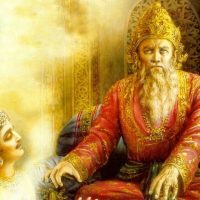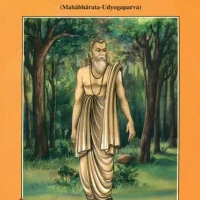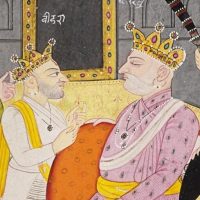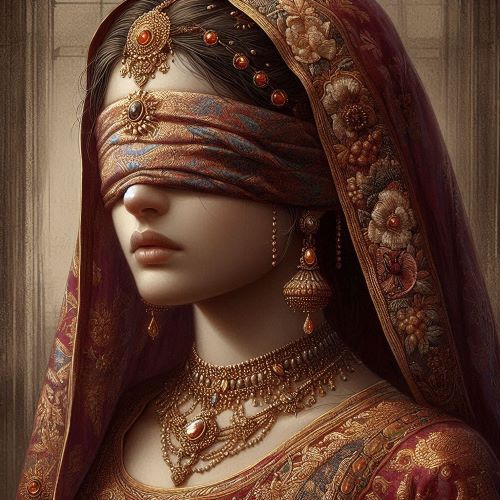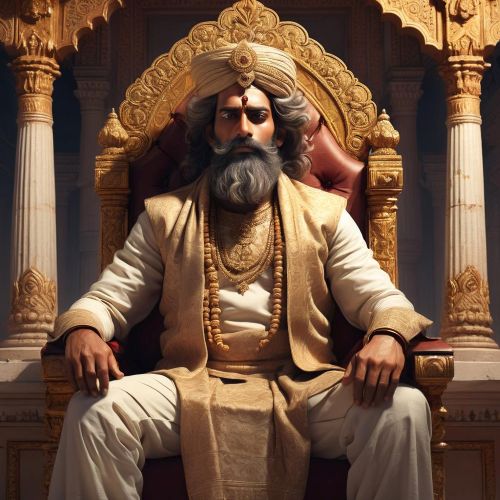Vidura : The Wise Counsel
Listen
At a glance
| Description | |
|---|---|
| Origin | Indian Mythology |
| Classification | Gods |
| Family Members | Vyasa (Father) |
| Region | India |
| Associated With | Wisdom, Dharma |
Vidura
Introduction
Vidura, one of the most revered figures in the Mahabharata, embodies wisdom, moral courage, and righteousness. Unlike warriors or kings, his greatness was not measured by might or lineage but by intellect and integrity. Born through the ancient practice of niyoga to sage Vyasa and a maidservant of Queen Ambika, Vidura was a half-brother to Dhritarashtra and Pandu. Though denied royal privilege due to his birth, his wisdom made him indispensable to the Kuru court as its Prime Minister. Vidura’s life is a striking example of how character and virtue can transcend the barriers of class and power. He remained the voice of truth amid deceit and ambition, always upholding dharma even when it meant opposing his own family. His teachings, later compiled as Vidura Niti, continue to serve as timeless guidelines for ethical governance, leadership, and personal conduct.
Physical Traits
The Mahabharata rarely emphasizes Vidura’s physical appearance, focusing instead on his serene and composed nature. Ancient texts describe him as dark-skinned, a reflection of his divine connection to Yama, the god of justice and death, whose reincarnation he was said to be. His calm demeanor and dignified presence conveyed authority without the need for grandeur. Unlike the royal princes, Vidura dressed simply, symbolizing detachment from material vanity. His eyes were said to reflect both compassion and clarity of judgment, marking him as a man of profound spiritual insight. In art and adaptations, Vidura is often shown seated in meditation or deep conversation—an image of balance between intellect and virtue.
Family
Vidura’s birth carries profound symbolic meaning in the Mahabharata. After the death of King Vichitravirya without heirs, his widowed queens Ambika and Ambalika were instructed by Satyavati to bear children through the sage Vyasa. However, both queens were overcome by fear or discomfort during the process, resulting in Dhritarashtra being born blind and Pandu pale and weak. When Satyavati sought a flawless heir, Vyasa united with a maidservant of Ambika, resulting in Vidura’s birth. Although he shared paternal blood with the royal line, his maternal origins as a servant’s son made him ineligible for the throne. Yet his moral authority often outweighed that of his noble brothers. Vidura was married to a woman of similar mixed lineage, and though little is mentioned about his descendants, his legacy endured through his wisdom rather than lineage. His deep affection for both the Pandavas and Kauravas made him the moral anchor of the Kuru dynasty.
Other names
Vidura’s name itself comes from the Sanskrit root vid, meaning “to know” or “to understand,” aligning with his role as the embodiment of wisdom. He was often addressed as Mahatma Vidura—“the great soul”—a title reflecting his purity of character and insight. Lord Krishna himself referred to him as Dharmaraja, not to be confused with Yudhishthira, acknowledging Vidura’s steadfast commitment to truth and righteousness. In certain theosophical traditions, he is known as Mahachohan, or the “chief of the wise,” and in some regional retellings, he is affectionately called Kaka Vidura, symbolizing his role as a wise and nurturing uncle figure. These titles highlight how his reputation transcended time and caste, marking him as a sage whose counsel illuminated even the darkest political intrigues of Hastinapur.
Powers and Abilities
Vidura’s powers were neither physical nor divine in the conventional sense; his strength lay in his intellect, foresight, and unwavering commitment to dharma. As the reincarnation of Yama, the god of justice, Vidura carried within him an innate understanding of morality and consequence. His discourses, compiled as Vidura Niti in the Udyoga Parva of the Mahabharata, form one of the earliest treatises on ethics, leadership, and governance. Through his teachings, Vidura explained that rulers must prioritize compassion, restraint, and fairness over ambition and desire.
Vidura’s moral courage was repeatedly tested. When Duryodhana conspired to burn the Pandavas alive in the Lakshagriha (house of lac), Vidura subtly warned Yudhishthira in a coded dialect, saving their lives. During the infamous dice game, he stood alone in condemning the humiliation of Draupadi, despite the silence of elders like Bhishma and Dhritarashtra. He was fearless in speaking truth to power, reminding Dhritarashtra of the perils of partiality and moral blindness. Vidura’s intellect and compassion made him both a strategist and a spiritual guide—his wisdom serving as a shield where weapons failed.
Modern Day Influence
Vidura’s relevance extends far beyond the epic age. His teachings in Vidura Niti are still referenced in discussions of ethical governance and political philosophy. The text elaborates on principles such as integrity in leadership, empathy toward subjects, and the dangers of greed and anger in rulers. Modern management and leadership scholars frequently compare Vidura’s counsel to the works of Chanakya and even to Western philosophers like Aristotle, who also emphasized moral virtue in governance. His philosophy promotes value-based leadership, stressing that real success lies in justice, compassion, and humility rather than power or wealth.
In popular culture, Vidura is consistently portrayed as the conscience of the Mahabharata. Television adaptations and literary retellings depict him as the one voice of truth in a kingdom clouded by ego and desire. His defiance against moral corruption has inspired generations, making him a symbol of ethical resistance and moral clarity. For Theosophists and Vedantists, Vidura represents the “inner voice” of conscience, guiding individuals toward righteous decision-making even in morally gray situations.
Modern scholars and spiritual teachers interpret Vidura’s life as a call for equality and meritocracy, challenging caste hierarchies that value birth over virtue. His story resonates deeply in today’s world, where moral integrity is often tested by ambition and politics. In educational institutions and business ethics programs, Vidura Niti is cited as a guide to cultivating wisdom-based leadership. Even digital platforms and artificial intelligence initiatives have invoked his name—some modern advisory chatbots are named “Vidura” to represent guidance rooted in ethics and intelligence.
Vidura’s enduring appeal lies in his ability to bridge spirituality and practicality. His life teaches that righteousness need not be loud, that integrity can exist without power, and that the truest form of strength is moral conviction. In every age, his legacy reminds humanity that wisdom, when combined with compassion, remains the most powerful force for justice and harmony.
Related Images
Source
Krishna.com. (2024, February 17). Vidura: A True Mahatma. Retrieved from https://btg.krishna.com/vidura-a-true-mahatma/
VyasaOnline. (2016, August 31). Vidura Encyclopedia Entry. Retrieved from https://www.vyasaonline.com/encyclopedia/vidura/
Wikipedia. (2004). Vidura. Retrieved from https://en.wikipedia.org/wiki/Vidura
JKYog. (2025, March 26). The Role of Vidur in the Mahabharata: A Symbol of Dharma. Retrieved from https://www.jkyog.org/blog/the-role-of-vidur-in-the-mahabharat/
Chanakya Policy Research. (2024, December 17). Vidur Neeti: Timeless Wisdom for Modern Governance and Politics.
Khirawdhi. (2025, March 12). Vidura: The Embodiment of Wisdom and Righteousness in the Mahabharata.
WisdomLib. (2024, April 27). Laws of Prosperity and Righteousness.
ISKCON Education. (n.d.). Vidura – An Epic Character of Mahabharat (PDF).
Frequently Asked Questions
What is lorem Ipsum?
I am text block. Click edit button to change this text. Lorem ipsum dolor sit amet, consectetur adipiscing elit. Ut elit tellus, luctus nec ullamcorper mattis, pulvinar dapibus leo.
What is lorem Ipsum?
I am text block. Click edit button to change this text. Lorem ipsum dolor sit amet, consectetur adipiscing elit. Ut elit tellus, luctus nec ullamcorper mattis, pulvinar dapibus leo.
What is lorem Ipsum?
I am text block. Click edit button to change this text. Lorem ipsum dolor sit amet, consectetur adipiscing elit. Ut elit tellus, luctus nec ullamcorper mattis, pulvinar dapibus leo.
What is lorem Ipsum?
I am text block. Click edit button to change this text. Lorem ipsum dolor sit amet, consectetur adipiscing elit. Ut elit tellus, luctus nec ullamcorper mattis, pulvinar dapibus leo.
What is lorem Ipsum?
I am text block. Click edit button to change this text. Lorem ipsum dolor sit amet, consectetur adipiscing elit. Ut elit tellus, luctus nec ullamcorper mattis, pulvinar dapibus leo.



